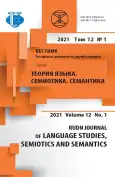Biz birgemiz, or Revisiting the Diversification of Russian Language in Kazakhstan
- 作者: Suleimenova E.D.1, Akanova D.K.2, Aimagambetova M.M.1
-
隶属关系:
- Al-Farabi Kazakh National University
- The University of Chicago
- 期: 卷 12, 编号 1 (2021)
- 页面: 7-22
- 栏目: FUNCTIONAL GRAMMAR & FUNCTIONAL SEMANTICS
- URL: https://journal-vniispk.ru/2313-2299/article/view/323391
- DOI: https://doi.org/10.22363/2313-2299-2021-12-1-7-22
- ID: 323391
如何引用文章
详细
The criteria for pluricentric languages, generalized by the Working Group on NonDominant Varieties of Pluricentric Languages (WGNDV), as well as our earlier condition of tightness, opacity, incomprehensibility of Kazakh Russian were used to discuss the possibility of its gradual formation. Two main conclusions were made: a) the Russian language of the post-Soviet space currently meets the criteria for pluricentric languages; b) the Russian language in Kazakhstan is going through rapid and noticeable diversification processes. The arguments of Kazakhstani linguists who assert (B.Kh. Khasanov, E.A. Zhuravleva, D.D. Shaibakova, etc.) or deny (Z.K. Sabitova, A.K. Kazkenova, etc.) the qualifications of the Russian language as variant in Kazakhstan - a country of long-term and massive Kazakh-Russian bilingualism. Generations of Russian speakers (monolinguals - ethnic Russians, Koreans, Ukrainians and others and bilinguals - Kazakhs, Uzbeks, Uighurs and others) with a dominant Russian or a dominant ethnic language - are involved in the processes of Soviet Russification and modern Kazakhization with different effects. Nowadays the diversification of the Russian language in Kazakhstan is taking place against the background of a fundamental change in the status and functional state of the Kazakh and Russian languages; reducing the number of native Russian speakers; fundamental changes in Kazakh-Russian bilingualism, reflected in the crisis of the linguistic identity of a part of Kazakhstanis, in a linguistic shift towards the Russian language (Koreans, part of Kazakhs, Ukrainians, small ethnic groups, etc.) and a turn of the linguistic shift of Kazakhs; strengthening the position of the Kazakh language in business, culture, education, mass media, interethnic communication; the changed vector of influence of languages (Kazakh Russian) and the openness of the Russian language for oral and written borrowings, especially in media texts; finally, new communication needs of Kazakhstanis. The long-term linguistic and cultural borderland, which forms the internalized conceptual-mental picture of the world inherent in Kazakhstanis, has become a fundamental factor stimulating the diversification processes of the Russian language in Kazakhstan.
作者简介
Eleonora Suleimenova
Al-Farabi Kazakh National University
编辑信件的主要联系方式.
Email: esuleim@gmail.com
Doctor sciences of Philology, professor, Foreign philology and translation studies, Faculty of Philology and World Languages
71, al-Farabi Ave., Almaty, Republic of Kazakhstan, 050040Dana Akanova
The University of Chicago
Email: dakanova@gmail.com
Ph.D.
5801 South Ellis Avenue, Chicago, Illinois, USA, 60637Malika Aimagambetova
Al-Farabi Kazakh National University
Email: aimagambetovamalika@gmail.com
Ph.D., Head of Department of Foreign philology and translation studies, Faculty of Philology and World Languages
71, al-Farabi Ave., Almaty, Republic of Kazakhstan, 050040参考
- Vahtin, N.B., Mustajoki, A. & Protasova, E.Yu. (2010). Russian languages. Slavica Helsingiensia, 40, 5—16. (In Russ.). URL: http://www.pluricentriclanguages.org (accessed:10.11.2020).
- Muhr, R. (2016). The state of the art of research on pluricentric languages: Where we were and where we are now In Pluricentric Languages and Non-Dominant Varieties Worldwide, Österreichisches deutsch sprache der gegenwart, R. Muhr (Ed.). Berlin. B. 18. pp. 13—40.
- Alisharieva, A., Ibraeva, Zh. & Protasova, E. (2017). Kazakh Russian: a view from the outside In Ab Imperio. The Global Condition: Local Names for Universalism. New York-Kazan’. Vol. 4. pp. 231—263. (In Russ.).
- Suleimenova, E.D. (2010). To understanding the likelihood of a variant of the Russian language in Kazakhstan. Slavica Helsingiensia, 40, 268—282. (In Russ.).
- Suleimenova, E.D. (2011). Language processes and politics. Almaty. (In Russ.).
- Hasanuly, B. (2007). Languages of the peoples of Kazakhstan: from silence to development strategy. Almaty. (In Russ.).
- Muhr, R. (2019). European pluricentric languages in contact and conflict In European Pluricentric Languages in Contact and Conflict, R. Muhr, J. Àngel, M. Castells, J. Rueter (Eds.). Österreichisches deutsch sprache der gegenwart Herausgegeben. Berlin. Book 21. pp. 11—64.
- Muhr, R. (2012). Linguistic Dominance and Non-Dominance in Pluricentric Languages: A. Typology In Non-Dominant Varietes of Pluricentric Languages. Frankfurt am Main. pp. 23—48.
- Bachtikireeva, U.M. (2014). Russian is a Multinational Language? Russian Journal of Linguistics, 2, 16—13. (In Russ.).
- Bachtikireeva, U.M. (2010). To the problem of variability of the Russian lexical system. RUDN Journal of Language Studies, Semiotics and Semantics, 3, 117—123. (In Russ.).
- Crystal, D. (1987). The Cambridge Encyclopedia of Language. Cambridge: Cambridge University Press.
- Shaibakova, D.D. (2006). The functioning of the inorganic language in a multiethnic society (based on the Russian language in Kazakhstan). Almaty. (In Russ.).
- Zhuravleva, E.A. (2007). Variation of the lexical system: Russian as a multinational language. Almaty, 2007. (In Russ.).
- Shaibakova, D.D. (2016). Is Russian pluricentric? Przegląd Wschodnioeuropejski, VII / 2, 257—268. (In Russ.).
- Sabitova, Z. (2014). Russian language in Kazakhstan: national variant? Slavica Helsingiensia, 45, 208—2017. (In Russ.).
- Kazkenova, A.K. (2017). Ontology of the borrowed word. Moscow. (In Russ.).
- Kazkenova, A. & Zhirenov, S. (2015). Independent development and mutual influence of the Kazakh and Russian languages in the Republic of Kazakhstan. Przegląd Wschodnioeuropejski, 6/1, 143—152. (In Russ.).
- Sinyachkin, V.P. (2011). Historical-and-cultural Turkisms layer in the everyday Russian language perception. RUDN Journal of Language Studies, Semiotics and Semantics, 4, 85—95. (In Russ.).
- Sarybai. URL: https://m.facebook.com/story.php?story_fbid=3753888887955752&id=100000 040344125 (accessed: 10.11.2020). (In Russ.).
- Suleimenova, E.D., Shaimerdenova, N.Zh. & Musabekova, U.E. (2015). Onomastics of Kazakhstan: geographical names and otonymic derivatives. More than 3000 units. Almaty. (In Russ.).
- Musataeva M., Nikitina S., Kazkenova A. Comprehensive dictionary of the Russian language. Almaty, 2005. (In Russ.).
- Russian National Corpus. URL: https://ruscorpora.ru/old (accessed: 10.11.2020). (In Russ.).
- Russian National Corpus. URL: https://ruscorpora.ru/new (accessed: 10.11.2020). (In Russ.).
- Havranek, B. (1972). On the problem of mixing languages In New in linguistics. Iss. VI. Moscow. pp. 9—111. (In Russ.).
补充文件









